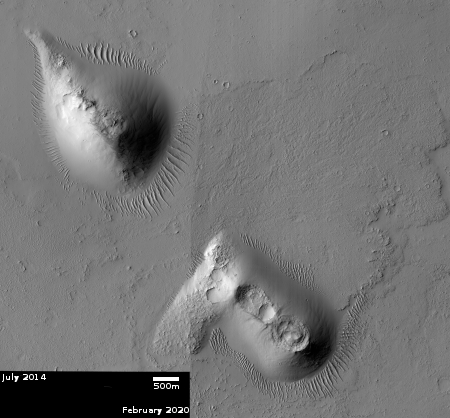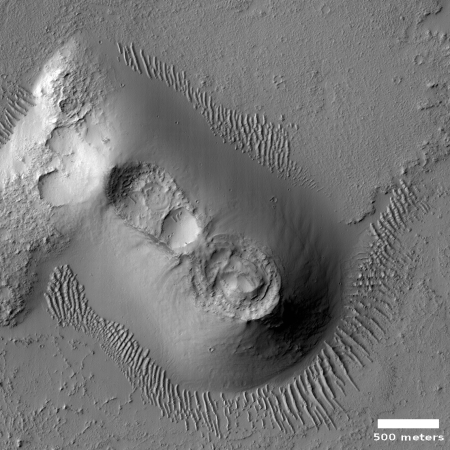Baby Martian volcanoes
Cool image time! I came across this strange feature shown on the right in my normal rummaging through the archive of the high resolution camera on Mars Reconnaissance Orbiter (MRO). The photo, rotated, cropped, and reduced to post here, focuses on what they label a “cratered cone.”
The immediate thought is that this is a volcano cone, and the craters at its peak are not impact craters but calderas. In science however such a knee-jerk conclusion is always dangerous. For example, this might instead be a pedestal crater, where the surrounding terrain was worn away over eons, leaving the crater sitting high and dry.
It is therefore important to look deeper to determine what origin of this feature might be.
First, its location, as shown in the overview map below, provides us our first clue.

This pimple on Mars, as indicated by the blue rectangle, is located on the very edge of the heavily fissured region called Noctis Fossae, just west of Valles Marineris and immediately north of the vast chaos region dubbed Noctis Labyrinthus.
Noctis Fossae is really an extension of Noctis Labyrinthus, but instead of canyons and fissures going in all directions, its fissures are all parallel in a north-south direction. This suggests they are volcanic cracks created when the underlying magma pushed the surface upward. As Noctis Fossae is part of the volcanic Tharsis Bulge region, with the string of three giant volcanoes just to the west, it is thus not surprising to find evidence of underlying volcanic pressure.
What other data do we have? Take another look at the overview map, obtained from the MRO high-res camera archive. The red rectangles scattered about are the locations of all the high resolution photos that MRO has so far taken in this area. Note how few there are. Surrounding this cone MRO has literally taken no other high resolution images, for many miles. This lack suggests that MRO’s context camera, designed to take lower resolution wide images, has not spotted any interesting features worth inspecting with high resolution follow-ups.

Click for full image of second cone.
However, when I took a close look at this particular spot, I discovered that one other picture had been taken in this region, and it happened to be located just to the northwest of this cratered cone, with an overlap. The mosaic to the right combines the above photo with that second image, showing that this cratered cone is also aligned with another cratered cone to northwest.
Their similarity and alignment argues against them being pedestal craters. Instead, it suggests an underground fault has provided a pathway for magma to push upward at both places, creating these small volcanoes. Furthermore, the second image had been given the title “Mound Surrounded by Lava Close to Noctis Fossae,” telling us that the MRO science team thought the surface here was volcanic in nature.
So, is it certain that these are volcano cones? Well, maybe. Though the data available suggests this conclusion, you must never forget the uncertainty of science. There is still the possibility that we are not seeing cones created by molten magma, but by underground water ice pushing mud upward, much as magma does. Such things have been found in the Martian northern lowlands (see here and here).
The universe is an amazing puzzle. Explaining it takes hard work, and a willingness to keep an open mind, at all times.
On Christmas Eve 1968 three Americans became the first humans to visit another world. What they did to celebrate was unexpected and profound, and will be remembered throughout all human history. Genesis: the Story of Apollo 8, Robert Zimmerman's classic history of humanity's first journey to another world, tells that story, and it is now available as both an ebook and an audiobook, both with a foreword by Valerie Anders and a new introduction by Robert Zimmerman.
The print edition can be purchased at Amazon or from any other book seller. If you want an autographed copy the price is $60 for the hardback and $45 for the paperback, plus $8 shipping for each. Go here for purchasing details. The ebook is available everywhere for $5.99 (before discount) at amazon, or direct from my ebook publisher, ebookit. If you buy it from ebookit you don't support the big tech companies and the author gets a bigger cut much sooner.
The audiobook is also available at all these vendors, and is also free with a 30-day trial membership to Audible.
"Not simply about one mission, [Genesis] is also the history of America's quest for the moon... Zimmerman has done a masterful job of tying disparate events together into a solid account of one of America's greatest human triumphs."--San Antonio Express-News
Cool image time! I came across this strange feature shown on the right in my normal rummaging through the archive of the high resolution camera on Mars Reconnaissance Orbiter (MRO). The photo, rotated, cropped, and reduced to post here, focuses on what they label a “cratered cone.”
The immediate thought is that this is a volcano cone, and the craters at its peak are not impact craters but calderas. In science however such a knee-jerk conclusion is always dangerous. For example, this might instead be a pedestal crater, where the surrounding terrain was worn away over eons, leaving the crater sitting high and dry.
It is therefore important to look deeper to determine what origin of this feature might be.
First, its location, as shown in the overview map below, provides us our first clue.

This pimple on Mars, as indicated by the blue rectangle, is located on the very edge of the heavily fissured region called Noctis Fossae, just west of Valles Marineris and immediately north of the vast chaos region dubbed Noctis Labyrinthus.
Noctis Fossae is really an extension of Noctis Labyrinthus, but instead of canyons and fissures going in all directions, its fissures are all parallel in a north-south direction. This suggests they are volcanic cracks created when the underlying magma pushed the surface upward. As Noctis Fossae is part of the volcanic Tharsis Bulge region, with the string of three giant volcanoes just to the west, it is thus not surprising to find evidence of underlying volcanic pressure.
What other data do we have? Take another look at the overview map, obtained from the MRO high-res camera archive. The red rectangles scattered about are the locations of all the high resolution photos that MRO has so far taken in this area. Note how few there are. Surrounding this cone MRO has literally taken no other high resolution images, for many miles. This lack suggests that MRO’s context camera, designed to take lower resolution wide images, has not spotted any interesting features worth inspecting with high resolution follow-ups.

Click for full image of second cone.
However, when I took a close look at this particular spot, I discovered that one other picture had been taken in this region, and it happened to be located just to the northwest of this cratered cone, with an overlap. The mosaic to the right combines the above photo with that second image, showing that this cratered cone is also aligned with another cratered cone to northwest.
Their similarity and alignment argues against them being pedestal craters. Instead, it suggests an underground fault has provided a pathway for magma to push upward at both places, creating these small volcanoes. Furthermore, the second image had been given the title “Mound Surrounded by Lava Close to Noctis Fossae,” telling us that the MRO science team thought the surface here was volcanic in nature.
So, is it certain that these are volcano cones? Well, maybe. Though the data available suggests this conclusion, you must never forget the uncertainty of science. There is still the possibility that we are not seeing cones created by molten magma, but by underground water ice pushing mud upward, much as magma does. Such things have been found in the Martian northern lowlands (see here and here).
The universe is an amazing puzzle. Explaining it takes hard work, and a willingness to keep an open mind, at all times.
On Christmas Eve 1968 three Americans became the first humans to visit another world. What they did to celebrate was unexpected and profound, and will be remembered throughout all human history. Genesis: the Story of Apollo 8, Robert Zimmerman's classic history of humanity's first journey to another world, tells that story, and it is now available as both an ebook and an audiobook, both with a foreword by Valerie Anders and a new introduction by Robert Zimmerman.
The print edition can be purchased at Amazon or from any other book seller. If you want an autographed copy the price is $60 for the hardback and $45 for the paperback, plus $8 shipping for each. Go here for purchasing details. The ebook is available everywhere for $5.99 (before discount) at amazon, or direct from my ebook publisher, ebookit. If you buy it from ebookit you don't support the big tech companies and the author gets a bigger cut much sooner.
The audiobook is also available at all these vendors, and is also free with a 30-day trial membership to Audible.
"Not simply about one mission, [Genesis] is also the history of America's quest for the moon... Zimmerman has done a masterful job of tying disparate events together into a solid account of one of America's greatest human triumphs."--San Antonio Express-News



Ahh little teenie weenie Volcanos on Mrs is that how Marvin and K-9 stay warm?